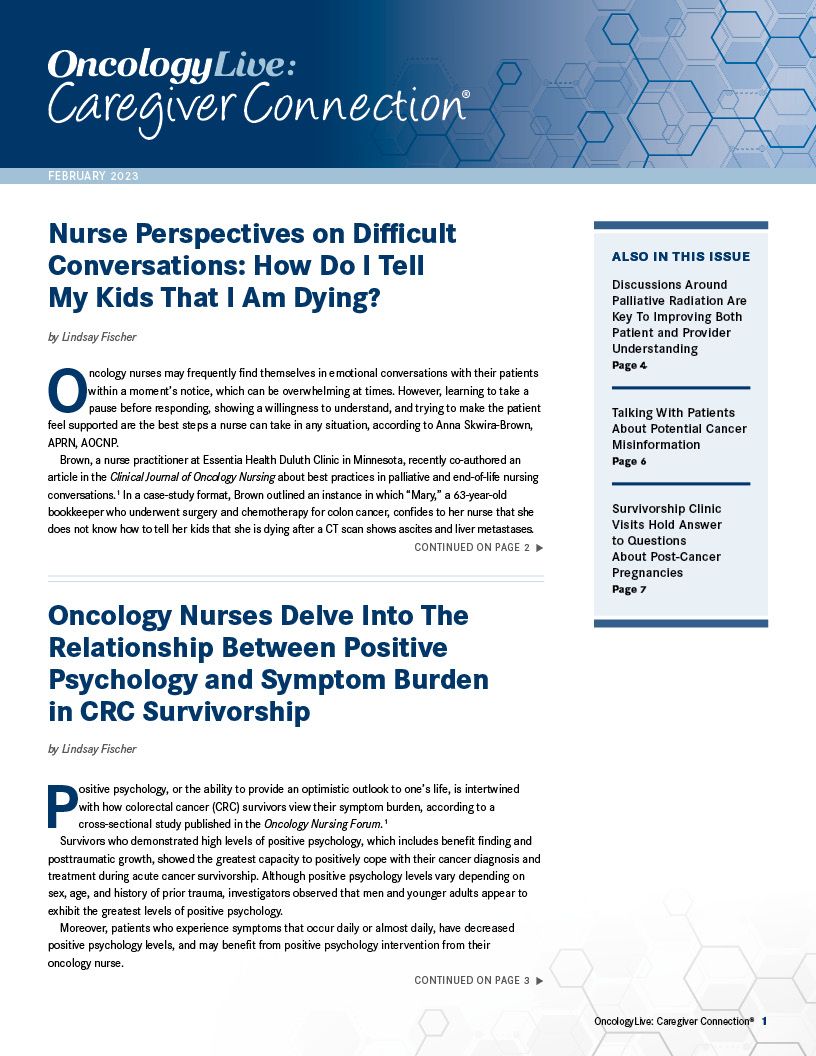Survivorship Clinic Visits Hold Answer to Questions About Post-Cancer Pregnancies
Ellen Miller, MSN, FNP-BC, a nurse practitioner who specializes in survivorship care, underscores what conversations surrounding fertility and pregnancy may look like after radiation.
Ellen Miller, MSN, FNP-BC

Although the frequency of cancer survivorship visits may vary on an individual patient basis, their role in cancer care remains crucial as long-term follow-up often reveals unique complications not seen during active treatment, according to Ellen Miller, MSN, FNP-BC.
Miller, who is a nurse practitioner at Vanderbilt University Medical Center, conducts routine follow-up and survivorship visits in the radiation oncology department. These appointments occur approximately 3 months after the completion of radiation therapy and cover content such as the long-term toxicities associated with treatments, the need for continued routine screenings (such as PAP and mammograms), and other additional resources.
Survivorship visits, however, may be even more nuanced, as patient needs continue to evolve on an individual basis. These visits usually begin a year posttreatment and can, according to Miller, include anything from “discussing the psychosocial ramifications of a cancer diagnosis and treatment to anxiety, fear of recurrence, [or] financial concerns.”
In one instance, Miller encountered a patient who had chosen to pursue pregnancy after electing not to undergo fertility preservation as a teenager. Although Miller herself is not a fertility specialist, she found this patient case interesting, and decided to delve into what fertility and pregnancy conversations between a provider and a patient may need to look like in the survivorship setting.
In an interview with Oncology Nursing News®, Miller discussed this unique patient case, and what her major takeaways from the experience were, highlighting resources that other nurse practitioners working in survivorship clinics might find useful.
A Personal Experience in Survivorship Treatment
In a survivorship visit, Miller met a 26-year-old woman who had undergone treatment at 19 for stage II natural killer/T-cell lymphoma of the nasal cavity.
This patient’s treatment included the SMILE chemotherapy regimen of dexamethasone, methotrexate, ifosfamide, asparaginase, and etoposide plus adjuvant radiation therapy of 50 Gy in 25 fractions. She completed treatment in April of 2017, but in December 2018 and August 2020 was given 4 weekly doses of rituximab (Rituxan) for a rising EBV titer. Miller explained that in this patient’s case, the chemotherapy ifosfamide could have had an impact on fertility.
Although she did not initially treat this patient after therapy, Miller noted that “this patient stated that her health care team discussed fertility preservation with her, but that she declined as she was 19 and thought she would not want to have children, but then as she got into her mid-20s and got married, her thoughts changed.”
Currently, this patient continues in survivorship care and was able to get pregnant without any medical intervention. Her daughter is doing well, and Miller advised her patient to consult with an OB/GYN or a fertility specialist in the future if she wants to pursue additional pregnancies.
The Process of Fertility Preservation
According to the Alliance for Fertility Preservation, the standard fertility preservation method for males is sperm banking. Other options included sperm extraction, electroejaculation, and testicular shielding from radiation—however, this is not always possible. Testicular tissue freezing is an experimental method of fertility preservation and includes freezing sperm to use for in vitro fertilization, testicular sperm extraction, and testicular shielding during radiation therapy. Females can freeze embryos (fertilized eggs) or oocytes (unfertilized eggs)—these are considered standard treatments. In certain cases, ovarian tissue may be frozen, and ovarian shielding and ovarian transposition may be options as well. Hormonal treatments for women are currently under investigation.1
Treatments That Can Cause Infertility
Radiation therapy, chemotherapy with alkylators and surgery may all effect fertility in males and females. The age of the patient, as well as the dose they receive, can impact the extent to which their fertility is impacted.2
Moreover, it can be difficult to assess fertility sometimes, according to Miller, because many treatments can cause temporary infertility. Additionally, certain treatments can cause premature menopause in women (mid to late 30s) and this can be an important factor to consider as well. Because women are born with all the eggs their bodies will produce, when treatments reduce egg supply, ovarian failure is a possibility. Chemotherapy can also severely damage those egg and surgeries such as hysterectomies affect fertility by limiting the ability to carry.
“Not only can chemotherapy damage existing eggs, but it can also lead patients to have early or premature menopause,” Miller emphasized.
Financial Aspects of Fertility Preservation
Unfortunately, cancer care costs may be high and paired with fertility preservation, can be difficult to manage as there are no federal laws requiring insurance companies to cover fertility preservation. States that have passed laws requiring coverage from insurance companies as of September 28, 2022, are California, Utah, Colorado, Illinois, New York, Maine, New Hampshire, Connecticut, New Jersey, Delaware, Maryland, and Rhode Island. Aside from these 12 states, the approximate cost off egg, embryo, and tissue freezing range from $10,000 to $15,000 plus storage fees and sperm banking costs between $500 to $1000 plus storage fees.1,3
“The out-of-pocket [cost] for fertility preservation is $10,000 to $15,000, on average. That’s hard for [anyone], not to mention a young male or female,” Miller said.
Discussing Pregnancy in Survivorship
Fortunately, this young woman was able to become pregnant naturally; however, the experience caused Miller to reflect on what pregnancy conversations should look like in the survivorship setting.
“[The] trajectory for her experience was standard, and we were thankful for that. But there are some reasons why some women would need further monitoring,” she noted.
For instance, for patients who received anthracycline chemotherapies, or left-sided chest radiation, cardiac monitoring is recommended, as both of these treatments can potentially damage the heart, and pregnancy can make the heart work harder.
“We’ve all probably heard of women who experience cardiomyopathy, even women [in the general population], because carrying a child can make your heart work harder,” Miller noted.
Moreover, certain doses of radiation therapy to the pelvis and abdomen can cause scar tissue and decrease the elasticity that allows the female body to stretch during pregnancy, while radiation therapy to the brain can also effect hormones such as follicle-stimulating hormone and luteinizing hormone. She added that “research indicates that sometimes [radiation] can impact the blood flow to the uterus, which could cause a risk of preterm birth or some of that growth restriction.” Consequently, these are all may be important to monitor in this setting.
But luckily, some research suggests that many women can safely have children after cancer treatment with minimal complications.
“Something I found in doing a little bit of research was a study that included several thousand offspring of female cancer survivors and male cancer survivors who were treated for cancers in their younger years,” she said. “They didn’t have an increased risk of any congenital abnormalities.”4
“Another piece of data that I found to be encouraging and helpful was that there was not a higher incidence of cancer in the children that were born of cancer survivors, unless the patient’s tumor was inherited, [such as] BRCA, lynch syndrome, etc.”
According to Miller, that data should be really encouraging for survivors, and nurses and nurse practitioners can reassure patients that there is hope for childbearing following cancer. She recommends informing the patients to involve an OB/GYN or fertility specialist if they do choose to pursue pregnancy.
Resources
References
- Quick Guide to Fertility Preservation. Triage Cancer. 2022.Accessed November 11, 2022. https://bit.ly/3Fh0IlY
- Fertility facts. Leukemia and Lymphoma Society. November 2014. Accessed November 11, 2022. https://bit.ly/3VK9JuW
- State laws and legislation. Alliance for Fertility Preservation. Accessed November 11, 2022. https://www.allianceforfertilitypreservation.org/state-legislation/
- Signorello LB, Mulvihill JJ, Green DM, et al. Congenital anomalies in the children of cancer survivors: a report from the childhood cancer survivor study. J Clin Oncol. 2012;30(3):239-245. doi:10.1200/JCO.2011.37.2938




